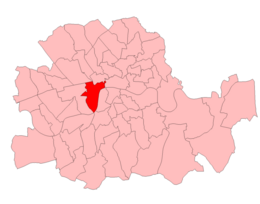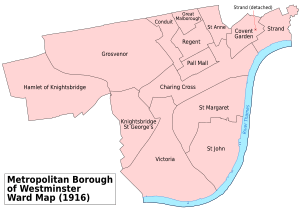Quick facts for kids {{{Name}}}
[[{{{Type}}} constituency]] |
[[Image:{{{Map1}}}Constituency.svg|120px|]]
[[Image:England{{{Map2}}}.svg|120px|]] |
| {{{Name}}} shown within [[{{{Entity}}}]], and {{{Entity}}} shown within England |
| Created: |
{{{Year}}} |
| MP: |
{{{MP}}} |
| Party: |
{{{Party}}} |
| Type: |
House of Commons |
| County: |
[[{{{County}}}]] |
| EP constituency: |
[[{{{EP}}} (European Parliament constituency)|{{{EP}}}]] |
Westminster Abbey was a constituency in the Parliament of the United Kingdom. It returned one Member of Parliament (MP) to the House of Commons by the first past the post system of election.
It was created for the 1918 general election, and included all of the former Westminster constituency, as reduced in area in 1885, apart from its Knightsbridge exclave, plus all of the former Strand constituency. It continued to exist until the 1950 general election, when it was merged with the two-seat City of London constituency to form a single-member seat named Cities of London and Westminster.
The seat was sometimes known as the Abbey Division of Westminster or simply Abbey. It was held by the Conservative Party for its entire existence.
Boundaries

Westminster Abbey in the Parliamentary County of London, 1918-50

A map showing the wards of Westminster Metropolitan Borough as they appeared in 1916.
The City of Westminster is a district of Inner London. Its southern boundary is on the north bank of the River Thames. In 1918 it was to the west of the City of London, to the south of Holborn and St. Pancras and to the east of Kensington and Chelsea. It consisted of the eastern part of the Metropolitan Borough of Westminster, comprising the then wards of Covent Garden, Great Marlborough, Pall Mall, Regent, St. Anne, St. John, St. Margaret, Strand and part of Charing Cross.
History
The constituency was created in 1918 from the former seats of Westminster & Strand. From 1918 to 1950, it returned five Conservative MPs, with Labour and the Liberals having little support in the area.
After William Burdett-Coutts, the first MP for the seat, died in 1921 there was a by-election where all three candidates claimed to be anti-waste. At the time the Anti-Waste League was active. It was formed to advance the political ambitions of the newspaper owner Lord Rothermere. The objects of the League were to insist upon measures being taken to restore the country to solvency, urge a wholesale reduction of expenditure, fight the battle of local rates and oppose sham Anti-Waste candidates. The Conservative candidate John Nicholson won the election, but the Anti-Waste League (whose candidate later became a Conservative MP) polled respectably and the Liberal candidate (a former MP) came third.
After Nicholson's death in 1924 a further by-election took place. The new Conservative candidate Otho Nicholson was challenged by the prominent politician Winston Churchill as a Constitutionalist, the formidable Labour stalwart and future MP Fenner Brockway, and a little-known Liberal. The Constitutionalist label was one used by a number of candidates, mostly ex-Liberals like Churchill, in the 1920s. The Constitutionalists did not function as a party and most of them ended up joining the Liberal or Conservative Parties. Nicholson beat Churchill with a very small majority of 43.
By the 1945 general election, the electorate of the area had dropped by almost half since the pre-war by-election. Labour almost equalled the 27% vote Brockway had received in 1924. The Independent Progressive candidate of 1939 reappeared as a Communist candidate and received 17.6% of the vote. The Conservatives still had an absolute majority of the vote. For the 1950 general election, the seat became the central part of the new constituency of Cities of London and Westminster.
Members of Parliament
Elections
1910s
1920s
| By-Election, 25 August 1921 |
| Party |
Candidate |
Votes |
% |
±% |
|
Unionist |
John Nicholson |
6,204 |
43.6 |
N/A |
|
Anti-Waste League |
Reginald Applin |
5,874 |
34.9 |
New |
|
Liberal |
Arnold Lupton |
3,053 |
21.5 |
New |
| Majority |
1,234 |
8.7 |
N/A |
| Turnout |
36,952 |
38.5 |
N/A |
|
Unionist hold |
Swing |
N/A |
|
| General election 1922: Westminster Abbey |
| Party |
Candidate |
Votes |
% |
±% |
|
Unionist |
John Nicholson |
13,620 |
75.6 |
N/A |
|
Labour |
Joseph George Butler |
2,454 |
13.6 |
New |
|
Independent |
Sidney Robert Drury-Lowe |
1,950 |
10.8 |
New |
| Majority |
11,166 |
62.0 |
N/A |
| Turnout |
36,763 |
49.0 |
N/A |
|
Unionist hold |
Swing |
N/A |
|
| By-Election, 19 March 1924 |
| Party |
Candidate |
Votes |
% |
±% |
|
Conservative |
Otho Nicholson |
8,187 |
35.9 |
N/A |
|
Constitutionalist |
Winston Churchill |
8,144 |
35.8 |
New |
|
Labour |
Fenner Brockway |
6,156 |
27.0 |
New |
|
Liberal |
James Scott Duckers |
291 |
1.3 |
New |
| Majority |
43 |
0.1 |
N/A |
| Turnout |
36,999 |
61.6 |
N/A |
|
Conservative hold |
Swing |
N/A |
|
| General election 1929: Westminster Abbey |
| Party |
Candidate |
Votes |
% |
±% |
|
Unionist |
Otho Nicholson |
18,195 |
74.0 |
-6.6 |
|
Labour |
James H MacDonnell |
6,406 |
26.0 |
+6.6 |
| Majority |
11,789 |
48.0 |
-13.2 |
| Turnout |
48,524 |
50.7 |
-7.7 |
|
Unionist hold |
Swing |
-6.6 |
|
1930s
| General election 1931: Westminster Abbey |
| Party |
Candidate |
Votes |
% |
±% |
|
Conservative |
Otho Nicholson |
Unopposed |
N/A |
N/A |
|
Conservative hold |
Swing |
N/A |
|
| 1932 Westminster Abbey by-election |
| Party |
Candidate |
Votes |
% |
±% |
|
Conservative |
Sidney Herbert |
Unopposed |
N/A |
N/A |
|
Conservative hold |
Swing |
N/A |
|
| General election 1935: Westminster Abbey |
| Party |
Candidate |
Votes |
% |
±% |
|
Conservative |
Sidney Herbert |
18,117 |
77.5 |
N/A |
|
Labour |
William Smith Kennedy |
5,255 |
22.5 |
New |
| Majority |
12,862 |
55.0 |
N/A |
| Turnout |
47,538 |
49.2 |
N/A |
|
Conservative hold |
Swing |
N/A |
|
| 1939 Westminster Abbey by-election |
| Party |
Candidate |
Votes |
% |
±% |
|
Conservative |
Harold Webbe |
9,678 |
67.4 |
-10.1 |
|
Independent Progressive |
G. Billy Carritt |
4,674 |
32.6 |
New |
| Majority |
5,004 |
34.8 |
-20.2 |
| Turnout |
47,396 |
30.3 |
-18.9 |
|
Conservative hold |
Swing |
N/A |
|
1940s
| General election 1945: Westminster Abbey |
| Party |
Candidate |
Votes |
% |
±% |
|
Conservative |
Harold Webbe |
9,160 |
54.4 |
-23.1 |
|
Labour |
Jeremy Hutchinson |
4,408 |
26.1 |
+3.6 |
|
Communist |
G. Billy Carritt |
2,964 |
17.6 |
New |
|
Democratic |
Norman Leith-Hay-Clark |
326 |
1.9 |
New |
| Majority |
4,752 |
28.3 |
-26.7 |
| Turnout |
28,823 |
58.5 |
+9.3 |
|
Conservative hold |
Swing |
N/A |
|




